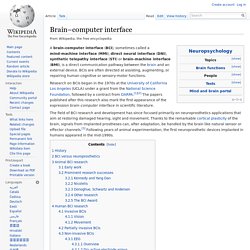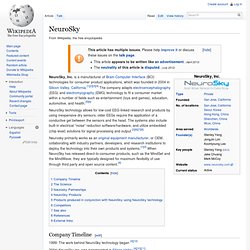

Wearable ‘neurocam’ records scenes when it detects user interest. Brain–computer interface. A brain–computer interface (BCI), sometimes called a mind-machine interface (MMI), direct neural interface (DNI), synthetic telepathy interface (STI) or brain–machine interface (BMI), is a direct communication pathway between the brain and an external device.

BCIs are often directed at assisting, augmenting, or repairing human cognitive or sensory-motor functions. Research on BCIs began in the 1970s at the University of California Los Angeles (UCLA) under a grant from the National Science Foundation, followed by a contract from DARPA.[1][2] The papers published after this research also mark the first appearance of the expression brain–computer interface in scientific literature. The field of BCI research and development has since focused primarily on neuroprosthetics applications that aim at restoring damaged hearing, sight and movement. History[edit] Berger's first recording device was very rudimentary. BCI versus neuroprosthetics[edit] Animal BCI research[edit] Early work[edit]
'Mind-reading' software could record your dreams - tech - 12 December 2008. Pictures you are observing can now be recreated with software that uses nothing but scans of your brain.

It is the first "mind reading" technology to create such images from scratch, rather than picking them out from a pool of possible images. Earlier this year Jack Gallant and colleagues at the University of California, Berkeley, showed that they could tell which of a set of images someone was looking at from a brain scan. To do this, they created software that compared the subject's brain activity while looking at an image with that captured while they were looking at "training" photographs. Computer can read letters directly from the brain - Radboud University. Brain Scanner Records Dreams on Video. Just a few weeks ago, we posted about how brain patterns can reveal almost exactly what you're thinking.

Now, researchers at UC Berkeley have figured out how to extract what you're picturing inside your head, and they can play it back on video. The way this works is very similar to the mind-reading technique that we covered earlier this month. A functional MRI (fMRI) machine watches the patterns that appear in people's brains as they watch a movie, and then correlates those patterns with the image on the screen. With these data, a complex computer model was created to predict the relationships between a given brain pattern and a given image, and a huge database was created that matched 18,000,000 seconds worth of random YouTube videos to possible brain patterns.
NeuroSky. NeuroSky, Inc. is a manufacturer of Brain-Computer Interface (BCI) technologies for consumer product applications, which was founded in 2004 in Silicon Valley, California.[1][2][3][4] The company adapts electroencephalography (EEG) and electromyography (EMG) technology to fit a consumer market within a number of fields such as entertainment (toys and games), education, automotive, and health.[5][6] NeuroSky technology allows for low-cost EEG-linked research and products by using inexpensive dry sensors; older EEGs require the application of a conductive gel between the sensors and the head.

The systems also include built-in electrical “noise” reduction software/hardware, and utilize embedded (chip level) solutions for signal processing and output.[2][6][7][8] Company Timeline[edit] Brain waves could quantify libido. Monitoring the change in specific brain waves could be the first quantitative method for measuring libido, new research suggests.

The technique measures attention, rather than sexual desire specifically, but Yoram Vardi, at Rambam Hospital and the Technion, both in Haifa, Israel told NewScientist: "We found that sexual stimuli are the most potent. " So far 30 people with normal sexual function have been tested, but if further tests are successful, Vardi hopes his method will have many applications. These could include quantitatively analysing the libido-lowering (or enhancing) side effects of medication or even supporting legal claims of a reduction in sex drive after an accident.
But he cautions that it is too early to say for sure whether it will be possible to establish an absolute measurement scale for libido. Random clips Vardi conducted experiments on 14 male and 16 female volunteers with normal sexual function. Standard stimulation. These Guys Are Creating a Brain Scanner You Can Print Out at Home. Biotech Breakthrough: Monkeys can feel virtual objects using a brain implant. World premiere of muscle and nerve controlled arm prosthesis.
A surgical team led by Dr Rickard Brånemark, Sahlgrenska University Hospital, has carried out the first operation of its kind, where neuromuscular electrodes have been permanently implanted in an amputee.

The operation was possible thanks to new advanced technology developed by Max Ortiz Catalan, supervised by Rickard Brånemark at Sahlgrenska University Hospital and Bo Håkansson at Chalmers University of Technology. “The new technology is a major breakthrough that has many advantages over current technology, which provides very limited functionality to patients with missing limbs,” says Rickard Brånemark. Big challengesThere have been two major issues on the advancement of robotic prostheses: 1) how to firmly attach an artificial limb to the human body; 2) how to intuitively and efficiently control the prosthesis in order to be truly useful and regain lost functionality. A sensational breakthrough: the first bionic hand that can feel - News - Gadgets & Tech.
The patient is an unnamed man in his 20s living in Rome who lost the lower part of his arm following an accident, said Silvestro Micera of the Ecole Polytechnique Federale de Lausanne in Switzerland.

The wiring of his new bionic hand will be connected to the patient’s nervous system with the hope that the man will be able to control the movements of the hand as well as receiving touch signals from the hand’s skin sensors. Dr Micera said that the hand will be attached directly to the patient’s nervous system via electrodes clipped onto two of the arm’s main nerves, the median and the ulnar nerves. This should allow the man to control the hand by his thoughts, as well as receiving sensory signals to his brain from the hand’s sensors.
2013/05/30 New Nerve and Muscle Interfaces Aid Wounded Warrior Amputees. May 30, 2013 Advances enable advanced prosthetic control and direct sensory feedback Since 2000, more than 2,000 servicemembers have suffered amputated limbs .

DARPA’s breakthrough research with advanced prosthetic limbs controlled by brain interfaces is well documented, but such research is currently limited to quadriplegics; practical applications of brain interfaces for amputees are still in the future. In contrast, nerve and muscle interfaces allow amputees to control advanced prosthetics in the near term. Txchnologist. February 19th, 2013 | by Charles Q.

Choi Temporary electronic tattoos could soon help people fly drones with only thought and talk seemingly telepathically without speech over smartphones, researchers say. Commanding machines using the brain is no longer the stuff of science fiction. In recent years, brain implants have enabled people to control robotics using only their minds, raising the prospect that one day patients could overcome disabilities using bionic limbs or mechanical exoskeletons. But brain implants are invasive technologies, probably of use only to people in medical need of them. His team is developing wireless flexible electronics one can apply on the forehead just like temporary tattoos to read brain activity. Scientists link rat brains together over the internet to transfer sensory information. Scientists have pulled off a real world, rodent-scale version of Vulcan "mind meld" from Star Trek, linking the brains of pairs of rats together over the internet to allow them to share sensory information and solve problems together in realtime without being in the same room, or even on the same continent.
